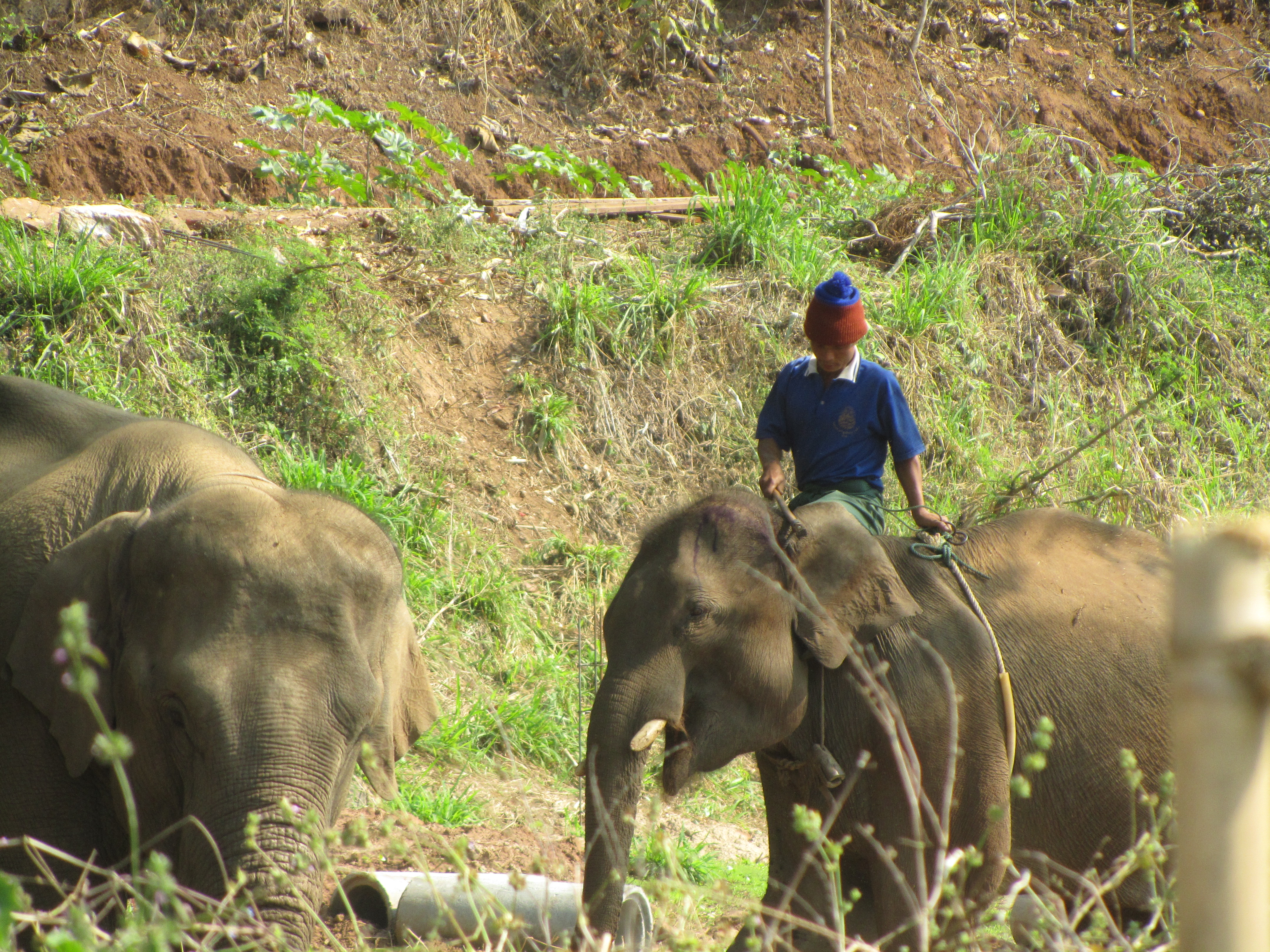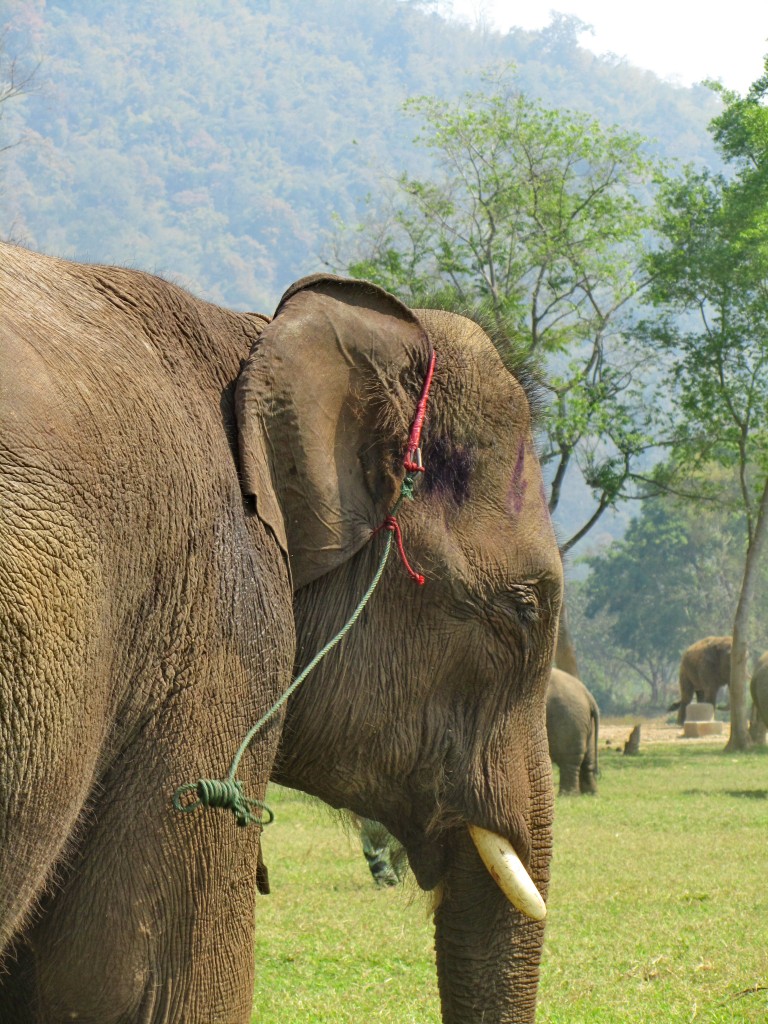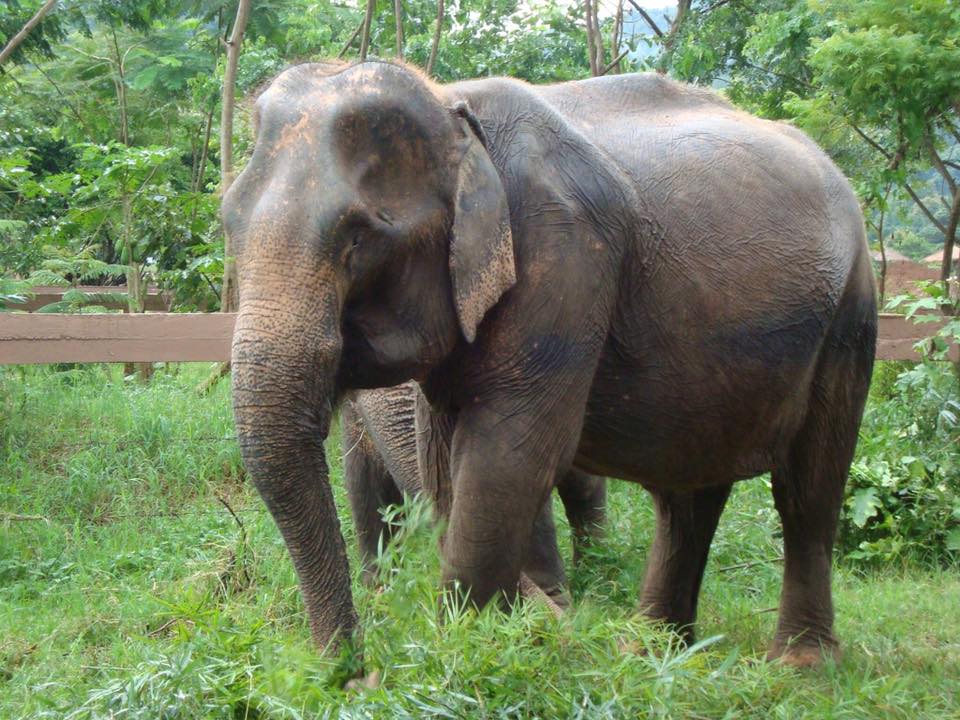Captive Elephants Escape From Nearby Trekking Camp to Elephant Nature Park
Things are changing in the Mae Taeng valley … it is not the quiet, secluded place it used to be. The realities of exploitative elephant tourism are now right next door and visible to us on a daily basis. Slowly but surely the land to the east of us has been bought up, initially being used for agriculture which limited our elephants grazing area. But, when the new land owners decided to build a restaurant/viewing platform and elephant camp beside us, our hearts sank.
You may ask “Why did we not buy this land well before it could be bought by others?” We did actually try. However, in this area much land for sale does not have a secure deed and buying this land could pose a risk. Also, the owner’s asking price is often twice the fair market value.
As a result, what we call the “back” of the park (where the view was pristine with no signs of human habitation) has now been spoiled by construction in progress and the sad sight of two young elephants on short chains, no access to water, heads bobbing endlessly in an act of infinite boredom. For the last two weeks or so, these poor elephants have been chained for most of the day, one within 10 feet of our property line. Obviously they can see, as well as communicate with our elephants.
Our herd has, of course, been curious about them. Faa Sai, defiantly ignoring the mahouts, has made several attempts to run over to meet the forlorn youngsters, Faa Mai and Chang Yim trundling along behind her. Knowing Faa Sai, she has probably been encouraging them to “break free and join the herd,” urging them to “resist and rebel,” and adding that “trekking is no life for an elephant.”
It was only a matter of time before something happened.
The first escape
The morning of February 8th was finally the moment.

The bull from the nearby mahout-for-a-day camp, along with the female, attempt to flee their captivity.
At 10:00 a.m. all was calm; most members of the family group were enjoying themselves at a swampy area, Mae Sri Nuan and Mae Thai off on their own. Ten minutes later, the two elephants who had been chained on the land next to us were in the act of challenging their mahouts. It all happened so quickly – one mahout was thrown off the elephant he was riding and the elephant turned on him to hit him while he was down, then quickly swirled back around and took off running, joining the other elephant whose mahout was sprinting behind desperately trying to stop the animal.
The pair headed straight for Mae Sri Nuan who was mildly surprised by their arrival. They stopped for a moment, but as soon as the mahouts attempted to gain control of them, these desperate youngsters took off running uncontrollably once again, doing everything they could to get to the family group.
Once amongst our herd, the pair settled down a bit.
Our understanding and protective elephants clustered around and comforted them with reassuring trunks, soothing them with subtle rumbles. Of our eles, the ones who seemed most sensitive to the trauma of the outsiders were Faa Sai and Tong Jaan. Both of these young ladies are very sensitive and are at the age where learning to care for and protect younger elephants is a way of life. The “runaways” looked to be in between the ages of Tong Jaan who just turned eight, and Faa Sai who is approximately 10.
It was touching and sad to see just how desperate these two elephants were to be in a social and nurturing situation. They seemed literally starved for this kind of attention.
Each time their mahouts made an effort to approach the pair, they adamantly resisted. At one point they took off running once again, this time joined by our concerned family members. Finally, the mahouts realized that the best thing was to just let them calm down before any more attempts were made to lead them back to their sad existence.
To try to make things easier Faa Mai, Chang Yim and the rest were called away. They hesitantly responded to their mahout’s request, worried about the fate of their new acquaintances. The “youngsters on the run’” took off yet again, this time heading towards Mae Perm and Jokia. It seemed that they were desperately looking for protection from any elephant in their path.
Finally, their mahouts were able to gain some semblance of control over the pair and they were led up to the road and back down to their life in purgatory, their short but sweet moment with the herd over.
Mahout for a day: the realities
These two young elephants are being used for the popular “mahout for a day” tourism phenomenon, where the inexperienced westerner — often with bull hook in hand — gets to “drive” an elephant with the mahout walking beside them. An accident waiting to happen, one of these two could bolt again, heading for the safety of Faa Sai and family, a tourist getting thrown off in the process, total chaos.

The painful contraption attached to the elephant’s ear as a part of the mahout-for-a-day program, along with the bull hook.
This “mahout for a day” concept is very stressful for an elephant. Having to endure inexperienced people sitting on their necks, with no prior elephant handling knowledge, is not fun or easy for the elephant. They often have a large fish hook-like thing draped over the top of their ear, close to their head. The point is very sharp and digs into the thin, sensitive ear skin. This is tied tightly around the ear and is very painful. A rope is attached to the other end and the mahout has hold of this when walking next to the elephant. If the elephant disobeys, the rope is yanked and the point pierces the skin, drawing blood.
For these particular elephants this situation is even worse than usual because they are located right next to Save Elephant Foundation’s Elephant Nature Park. They are currently leased by a new operation that does not yet have many customers. This means that the young elephants are tethered for the entire day on short chains, not even within reach of each other. They have nothing to do except gaze out at the Elephant Nature Park family group who are roaming chain free, playing in the river whenever they wish and most of all enjoying each other’s company.
Imagine how these two young elephants must feel … how hopeless … desperate …
The second escape
In fact, so very desperate that only four days later on February 12th, they made a run for the safety of the Elephant Nature Park once again!
On this day they made it much farther inside the park and the incident caused a bigger disturbance. Their mahouts were close behind, wielding hooks, as well as bamboo poles with sharp nails at the ends. They had lost their patience and meant business.
Once again Faa Mai, Faa Sai and the others clustered around to comfort and protect them. Their mahouts had no time for this socializing and wanted to gain control as soon as possible. It was a sad reality to see these young elephants dealt with so harshly and led away, as if prisoners on their way to solitary confinement – which in many ways was exactly what they were.
Life is not going to get any easier for this pair anytime soon.
Since that last escape there have been a few tourists. Somehow, completely oblivious to the horrific cruelty that they are supporting and partaking in, they happily await climbing aboard the reluctant young elephant. Fear is evident in his eyes, heavy chains to subdue him draped upon his neck, sharp hook fixed to his ear, a painful reminder to obey – not question authority. Somehow, the customer has failed to notice any of this — even the pole with the sharp nail at the end that the mahout is holding.
Oh, but “don’t worry … the elephant’s skin is very thick; this nail stabbing him does not hurt at all.”
It is saddening to see just how many uneducated tourists are still out there. How anyone could look that young bull in the eye and NOT see how miserable he was, is just shocking.
Our reality
We have much to do. There are no easy answers. We can’t rescue every elephant out there, though we wish we could. Much more land is needed — thousands of forested, mountainous acres, so that the elephants can finally be free of the necessity for a mahout at all. That is the end goal. In fact, we are currently running a raffle where one lucky winner will win a free week volunteering at the park, and all monies will go directly towards our land fund so we can purchase more land in order to continue rescuing elephants.
In the meantime, education is our best weapon. We who love elephants and who have voices must speak out for them and do everything in our power to make the blind see and the deaf hear … before it is to late.
Comments are closed.







This is a very touching story…one that seems to be only the beginning. The only thing worse than being held captive is being able to see and communicate with others not are not. We need to abolish slavery of all kinds.
This is horrible. Why are those men allowed at the property at all? Can someone put signs so that the tourists can read what they do to elephants?. These mahouts should be shot.
Hi Erick,
It’s definitely a horrible situation for those elephants. But, remember, mahouts must go to where their elephants go. If our elephants stray away from our property, our mahouts must follow and try to bring them back. Also, we work hard to educate both tourists AND mahouts, and show that there are more elephant-friendly ways of enjoying elephants. Signs near our property lines might be a great way to inform and educate. Thanks for the tip! 🙂
Signs indeed.. was goin to make my own banners for tourists as I worked in that area!
Tears in my eyes , heartbreaking, freedom is just 1 fence away, isn,t it possible buy them free, we need to stop this cruel slavery, stupid tourists eigther how is it possible to fail…not see THE cruelty littairly at 1 Side of THE fence and freedom on THE other poor poor elephants
Hi Tamara. We cannot buy these elephants. We do not buy young elephants since this encourages the active practice of capturing youngsters from the wild and making them captive. The foundation rescues those in desperate need — namely old and injured elephants who need to retire. At this time, we are actually unable to rescue any additional elephants as our land at Elephant Nature Park is at capacity. There is land across the river we would like to purchase (which is currently being leased by a trekking outfit), but the cost is $2 million USD. It is a very hard thing to witness, but if we WERE to purchase them, it would send the message to other camps that they can make money from selling healthy elephants and simply go and buy more and sell them for even more money.
Hey Team
Ive got a few questions
How did the park Eles react to the mahouts with the hook?
Did the two run aways get hit on the park grounds?
Could you talk to the mahouts and tell them that they are not allowed to bring the hook or pole onto park grounds?
Cheers Shaun
We will ask Jodi — she is the one who wrote this story.
Can someone ‘buy’ these youngsters and place them with you so that they can have a ‘real’ life? If so how much do we need to raise? I live in Canada and will do my best to raise whatever is needed to rescue these slaves to tourists. I am APPALLED that these kinds of tourists are so blind to what is happening. I have a friend who said he was going to Thailand one day and I made him promise to NEVER ride an elephant because of the cruelty involved in this sickening exploitation. I too am coming for a visit but I don’t know if I will be able to contain my outrage of what is happening for elephants in Asian countries.
Noella
Noella, we do not buy young elephants since this encourages the active practice of capturing youngsters from the wild and making them captive. The foundation rescues those in desperate need — namely old and injured elephants who need to retire. At this time, we are actually unable to rescue any additional elephants as our land at Elephant Nature Park is at capacity. There is land across the river we would like to purchase (which is currently being leased by a trekking outfit), but the cost is $2 million USD. I know it is hard to contain your outrage, but the best thing you can do is channel that and use it to educate others in a constructive way. 🙂
Dear Lek:
This is so so sad and so stressful for these two poor elephants. IS there anyway you can teach and educate the mahouts to be KIND to their elephants instead of the brutal force. Maybe get Carol Buckley over there because she teaches with touch and command. Elephants are so smart and they can learn without torture!!
Cindy, we do educate other camps about our methods of positive reinforcement. It is just not easy to change the mindset.
is it possible to allow the working elephants time in the park for rest and relaxation? their social needs could be fulfilled, the mahouts could have a break, maybe even teach the mahouts how to work with the elephants without poking and jabbing them? carol buckley is in nepal teaching a conservation center to go chainfree and work without bullhooks.
Hi Judith, unfortunately, we cannot do this as these elephants do not belong to us, but another camp. Sadly, even if we COULD provide this to these two captive elephants, we do not have the land to hold another two. We work hard to educate other camps about our methods of positive reinforcement.
Wow this is a very emotional blog post. My heart is hurting for those poor Ele’s. All they want is freedom & love. Running to ENP for protection & comfort, just soul crushing. I work everyday to make the world a better place for Elephants. So heartbreaking for those Ele’s! I just purchased some raffle tickets my hope that you will be able to buy more land to bring peace & freedom to more lives. Mahalo ENP xo
Thank you, Cindy, for your support. This post was very emotional and it made our hearts hurt, too.
I relate to how they feel…. it’s all I’m saying
I meant the elephants…
I like the sign idea, too ! The tourists will see them and it will make them think. Who in their right mind wants to be a ” mahout for the day”? And it’s horrible for the two young males that they have to be next to your loving herd and can’t get to them . But I can only pray the tourists will see this situation for what it is and the people who bought this land will not see it as a way to exploit elephants !!
Sadly, many people don’t know or understand the plight of Asian elephants and have no idea that these programs can be harmful to the elephants. The best thing we can do is educate future visitors to Thailand about what goes on and hope they will listen and tell others.
Czego nie robi się dla kasy, najsmutniejsza (oczywiście prócz tragedii słoni) jest bezmyślność turystów i okrucieństwo tubylców :(((
I worked at a camp 20 mins away from ENP and was appalled to see those elephants chained right beside a free range camp. I have photographs of one that appeared not only in distress but pain.. during my time working with mahouts, I aimed to gently work with them and encourage conversation which in turn can asssist with discussing nurturing and compassionate approaches. It’s a grass roots change and mahouts along with foreigners need education and new insights. I agree with the signage approach for tourists to read and was thinking of making banners myself whilst at my camp. Great idea for ENP as tourists are also travelling those ways to view the long neck tribe and other animal rides! I am in Chiang mai at the moment and will attempt to get further involved with ENP and only hope to as an employee in future to make social and respectful culture change to honour the animal that symbolises their country and adhere to Buddhist principles of equality and respect. I would post the pictures of this inhumane practice if there was the option as I stopped by the road to purposely capture it, noticing one was in visible pain 🙁